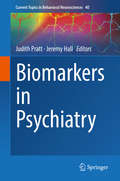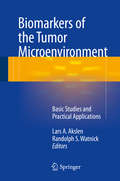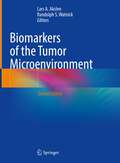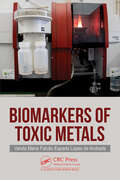- Table View
- List View
Biomarkers in Carcinoma of Unknown Primary
by Sulen Sarioglu Ozgul Sagol Anil AysalThis book aims to examine all immunohistochemical and molecular pathological biomarkers that can be useful and effective in patient diagnosis, prognosis and treatment decision, especially when faced with a carcinoma of unknown primary. For this purpose, epithelial malignancies of all systems and related biomarkers are examined one by one, and to look at the subject through the metastatic regions window, biomarkers that can be used to determine the primary focus for carcinomas seen in the areas most frequently metastasized are emphasized. With this bi-directional perspective, the reader is able to find biomarkers of any type of carcinoma on a system basis, as well as access to which biomarkers can be used when faced with a metastatic carcinoma. The importance of biomarkers in patient follow-up and treatment is also conveyed through the clinician's eye, and so biomarkers are handled with a holistic approach in all aspects. This book primarily targets pathologists, as well as clinicians (oncologists and surgeons) who manage cancer patients.
Biomarkers in Cardiovascular Disease
by Vijay NambiGet a quick, expert overview of the ways in which biomarkers can be used to assess and guide the management of cardiovascular disease in the clinical setting. This concise, clinically-focused resource by Dr. Vijay Nambi consolidates today's available information on this rapidly changing topic into one convenient resource, making it an ideal, easy-to-digest reference for cardiology practitioners, fellows, and residents. - Covers lab standards and statistical interpretation of biomarkers with a clinical focus. - Discusses relevant conditions such as hypertension and diabetes as key markers of injury and prognosis. - Includes current information on biomarkers to assess and guide the management of heart failure, acute coronary syndrome, chest pain, shortness of breath, and more. - Concludes the book with a timely chapter on how biomarkers may guide cardiologists in the future.
Biomarkers in Cardiovascular Diseases
by Dimitris Tousoulis Christodoulos StefanadisThe establishment of precise and reliable biomarker tests for the early stages of cardiovascular disease is of great importance and can be the cornerstone in the prevention of future cardiovascular disease (CVD). Furthermore, some biomarkers may provide important information concerning the pathogenesis of CVD or appear to be useful in risk stratifi
Biomarkers in Clinical Drug Development
by John Bloom Richard A. DeanPresenting applications in clinical development, pharmacokinetic/ pharmacodynamic modelling and clinical trial simulation, this reference studies the role of biomarkers in successful drug formulation and development.
Biomarkers in Drug Development: A Handbook of Practice, Application, and Strategy
by Michael R. Bleavins Claudio Carini Mallé Jurima-Romet Ramin Rahbari Mall 233 Jurima-RometDiscover how biomarkers can boost the success rate of drug development efforts As pharmaceutical companies struggle to improve the success rate and cost-effectiveness of the drug development process, biomarkers have emerged as a valuable tool. This book synthesizes and reviews the latest efforts to identify, develop, and integrate biomarkers as a key strategy in translational medicine and the drug development process. Filled with case studies, the book demonstrates how biomarkers can improve drug development timelines, lower costs, facilitate better compound selection, reduce late-stage attrition, and open the door to personalized medicine. Biomarkers in Drug Development is divided into eight parts: Part One offers an overview of biomarkers and their role in drug development. Part Two highlights important technologies to help researchers identify new biomarkers. Part Three examines the characterization and validation process for both drugs and diagnostics, and provides practical advice on appropriate statistical methods to ensure that biomarkers fulfill their intended purpose. Parts Four through Six examine the application of biomarkers in discovery, preclinical safety assessment, clinical trials, and translational medicine. Part Seven focuses on lessons learned and the practical aspects of implementing biomarkers in drug development programs. Part Eight explores future trends and issues, including data integration, personalized medicine, and ethical concerns. Each of the thirty-eight chapters was contributed by one or more leading experts, including scientists from biotechnology and pharmaceutical firms, academia, and the U.S. Food and Drug Administration. Their contributions offer pharmaceutical and clinical researchers the most up-to-date understanding of the strategies used for and applications of biomarkers in drug development.
Biomarkers in Drug Development: A Handbook of Practice, Application, and Strategy
by Michael R. Bleavins DabtDiscover how biomarkers can boost the success rate of drug development efforts As pharmaceutical companies struggle to improve the success rate and cost-effectiveness of the drug development process, biomarkers have emerged as a valuable tool. This book synthesizes and reviews the latest efforts to identify, develop, and integrate biomarkers as a key strategy in translational medicine and the drug development process. Filled with case studies, the book demonstrates how biomarkers can improve drug development timelines, lower costs, facilitate better compound selection, reduce late-stage attrition, and open the door to personalized medicine. Biomarkers in Drug Development is divided into eight parts: Part One offers an overview of biomarkers and their role in drug development. Part Two highlights important technologies to help researchers identify new biomarkers. Part Three examines the characterization and validation process for both drugs and diagnostics, and provides practical advice on appropriate statistical methods to ensure that biomarkers fulfill their intended purpose. Parts Four through Six examine the application of biomarkers in discovery, preclinical safety assessment, clinical trials, and translational medicine. Part Seven focuses on lessons learned and the practical aspects of implementing biomarkers in drug development programs. Part Eight explores future trends and issues, including data integration, personalized medicine, and ethical concerns. Each of the thirty-eight chapters was contributed by one or more leading experts, including scientists from biotechnology and pharmaceutical firms, academia, and the U.S. Food and Drug Administration. Their contributions offer pharmaceutical and clinical researchers the most up-to-date understanding of the strategies used for and applications of biomarkers in drug development.
Biomarkers in Drug Discovery and Development: A Handbook of Practice, Application, and Strategy
by Michael R. Bleavins Ramin Rahbari Jonathan Van NiewaalThis book continues the legacy of a well-established reference within the pharmaceutical industry – providing perspective, covering recent developments in technologies that have enabled the expanded use of biomarkers, and discussing biomarker characterization and validation and applications throughout drug discovery and development.• Explains where proper use of biomarkers can substantively impact drug development timelines and costs, enable selection of better compounds and reduce late stage attrition, and facilitate personalized medicine• Helps readers get a better understanding of biomarkers and how to use them, for example which are accepted by regulators and which still non-validated and exploratory• Updates developments in genomic sequencing, and application of large data sets into pre-clinical and clinical testing; and adds new material on data mining, economics, and decision making, personal genetic tools, and wearable monitoring• Includes case studies of biomarkers that have helped and hindered decision making• Reviews of the first edition: “If you are interested in biomarkers, and it is difficult to imagine anyone reading this who wouldn't be, then this book is for you." (ISSX) and “…provides a good introduction for those new to the area, and yet it can also serve as a detailed reference manual for those practically involved in biomarker implementation.” (ChemMedChem)
Biomarkers in Drug Discovery and Development: A Handbook of Practice, Application, and Strategy
by Michael R. Bleavins Ramin Rahbari Jonathan Van NiewaalThis book continues the legacy of a well-established reference within the pharmaceutical industry – providing perspective, covering recent developments in technologies that have enabled the expanded use of biomarkers, and discussing biomarker characterization and validation and applications throughout drug discovery and development.• Explains where proper use of biomarkers can substantively impact drug development timelines and costs, enable selection of better compounds and reduce late stage attrition, and facilitate personalized medicine• Helps readers get a better understanding of biomarkers and how to use them, for example which are accepted by regulators and which still non-validated and exploratory• Updates developments in genomic sequencing, and application of large data sets into pre-clinical and clinical testing; and adds new material on data mining, economics, and decision making, personal genetic tools, and wearable monitoring• Includes case studies of biomarkers that have helped and hindered decision making• Reviews of the first edition: “If you are interested in biomarkers, and it is difficult to imagine anyone reading this who wouldn't be, then this book is for you." (ISSX) and “…provides a good introduction for those new to the area, and yet it can also serve as a detailed reference manual for those practically involved in biomarker implementation.” (ChemMedChem)
Biomarkers in Heart Disease (American Heart Association Clinical Series #7)
by James De LemosBiomarkers in Heart Disease is the first title in the AHA Clinical Series and is aimed at meeting the needs of clinicians, providing cardiologists, internists, emergency physicians, laboratorians, and other healthcare providers with a clear understanding of the role of biomarkers in contemporary cardiovascular medicine. The book covers both the strengths and pitfalls of currently available markers, and provides information on the most promising biomarkers that are likely to impact practice in the next few years. It is divided into four parts, organized around clinical scenarios rather than individual biomarkers. This book will help the practicing physician decide which biomarkers to measure, when to measure them, how to interpret the results and how to make decisions based on the test result.
Biomarkers in Inflammatory Bowel Diseases
by Nik Sheng Ding Peter De CruzThis book provides a comprehensive and complete overview of biomarkers in clinical practice for inflammatory bowel disease (IBD) bringing together the literature in a clear and concise manner. The book bridges the gap between growing knowledge at the bench and current and future applications of biomarkers in clinical practice. The central structure of the book focuses on prognostic and predictive biomarkers in IBD with an emphasis on the fields of research and scientific techniques (genomics, proteomics and metabonomics) that have led to biomarker discovery and places these biomarkers within a clinical context to help understand their utility in clinical practice.This book will be of use to clinicians who have an interest in using biomarkers in clinical practice as well as clinician researchers and scientists involved in the biomarker research pipeline.The author team comprises experts from around the world in order to bring together the literature in an effort to inform clinicians and researchers about the current state-of-the art in biomarker discovery. It is intended to assist future research efforts and indicate how biomarkers might be best applied to clinical practice both at present and in the future.
Biomarkers in Neoplastic Neuropathology
by Fausto Rodriguez Cheng-Ying HoThis book is a rich source of information on biomarkers applicable to the pathology of neoplastic disorders of the brain. Thorough descriptions are provided of the techniques currently available for clinical and experimental evaluation of biomarkers in brain neoplasms, including in situ hybridization, array-based methods, methylation profiling, next-generation sequencing, and practical gene panels. Incorporation of multiple biomarkers in the development of molecular subgroups with biologic and therapeutic relevance is also discussed. A section on biobanking covers the equally important topic of optimal preservation of tissue and includes consideration of ethical considerations raised by the use of tissue obtained in clinical settings. The closing section discusses the major categories of neoplastic disorders involving the nervous system, with emphasis on diagnostic, prognostic, and predictive biomarkers used in the pathologic evaluation of different types of brain tumor.
Biomarkers in Neuropsychiatry: A Primer
by Michael Berk Antonio L. Teixeira Natalia P. RochaThis book presents the ‘state of the art’ of biomarkers research in neuropsychiatric conditions, from dementia to eating disorders, as well as providing methodological, practical and ethical issues related to the development of biomarkers. Biomarkers have revolutionized clinical research and practice in most fields of medicine, but psychiatry has lagged behind. However, in the last decade, there has been a growing expectation that biomarkers will advance and, ultimately, reframe psychiatry research and practice. Biomarkers might inform about diagnosis, therapeutics, prognosis, contributing to a ‘personalized medicine’. Understanding their meaning, possibilities and limitations will help clinicians, researchers and students in the related areas navigate and excel in the challenging and ever changing field of neuropsychiatric disorders.
Biomarkers in Periodontal Health and Disease: Rationale, Benefits, and Future Directions
by Nurcan BuduneliThis book examines all aspects of the progress being made towards the development of highly specific and sensitive biomarkers that will overcome the shortcomings of clinical assessments in periodontics. The opening chapters present the basic anatomic features of periodontal tissues, outline the nature and pathogenic mechanisms of periodontal diseases, and discuss both conventional and novel methods of diagnosis with reference to their specificity and sensitivity. The potential role of biomarkers in periodontal diagnosis is then presented in the light of the published data. The biological samples in which potential biomarkers are sought are evaluated comparatively, drawing attention to their strengths and weaknesses, and the available technologies for biomarker studies are reviewed. The potential benefits of biomarkers are also discussed with regard to the possible bidirectional interactions between periodontal diseases and systemic health. Finally, the past, present, and future of periodontics are examined from a broader perspective. Readers will find the book to be an ideal summary of the state of the art in the field as biomarkers emerge that promise to facilitate periodontal diagnostics and permit timely, personally tailored interventions.
Biomarkers in Psychiatry (Current Topics in Behavioral Neurosciences #40)
by Judith Pratt Jeremy HallThis volume addresses one of the Holy Grails in Psychiatry, namely the evidence for and potential to adopt ‘Biomarkers’ for prevention, diagnosis, and treatment responses in mental health conditions. It meshes together state of the art research from international renowned pre-clinical and clinical scientists to illustrate how the fields of anxiety disorders, depression, psychotic disorders, and autism spectrum disorder have advanced in recent years.
Biomarkers of Brain Injury and Neurological Disorders
by Kevin K. W. Wang Zhiqun Zhang Firas H. KobeissyThis book explores the recent advances in the techniques and platforms used in biomarker research that have revolutionized the way we study, diagnose, and treat brain injury conditions. The contributors describe different biomarker studies pertaining to brain injury and other neurological disorders and analyze the different models and technologies
Biomarkers of Cardiometabolic Risk, Inflammation and Disease
by Filipe Palavra Flávio Reis Daniela Marado Armando SenaThis book discusses recent advances in the area of cardiometabolic risk biomarkers of chronic inflammatory and cardiovascular disorders. Tackling the topic in a systematic manner, the book starts with an introduction to cardiometabolic risk and its clinical relevance, comparing emergent and classical biomarkers. It then goes on to discuss cardiometabolic risk biomarkers in a range of diseases, including diabetes, ischemic stroke and neurodegenerative disorders. Biomarkers of Cardiometabolic Risk, Inflammation and Disease is aimed at doctors specializing in internal medicine, neurology, cardiology, rheumatology, nephrology or endocrinology and will also be of interest to GPs, trainee doctors and clinical and basic researchers working on cardiovascular and autoimmune disorders.
Biomarkers of Human Aging (Healthy Ageing and Longevity #10)
by Alexey MoskalevThis book collects and reviews, for the first time, a wide range of advances in the area of human aging biomarkers. This accumulated data allows researchers to assess the rate of aging processes in various organs and systems, and to individually monitor the effectiveness of therapies intended to slow aging. In an introductory chapter, the editor defines biomarkers of aging as molecular, cellular and physiological parameters that demonstrate reproducible changes - quantitative or qualitative - with age. The introduction recounts a study which aimed to create a universal model of biological age, whose most predictive parameters were albumin and alkaline phosphatase (indication liver function), glucose (metabolic syndrome), erythrocytes (respiratory function) and urea (renal function). The book goes on to describe DNA methylation, known as the “epigenetic clock,” as currently the most comprehensive predictor of total mortality. It is also useful for predicting mortality from cancer and cardiovascular diseases, and for analyzing the effects of lifestyle factors including diet, exercise, and education. Individual contributions draw additional insight from research on genetics and epigenetic aging markers, and immunosenescence and inflammaging markers. A concluding chapter outlines the challenge of integrating of biological and clinical markers of aging. Biomarkers of Human Aging is written for professionals and practitioners engaged in the study of aging, and will be useful to both advanced students and researchers.
Biomarkers of Radiation in the Environment: Robust Tools for Risk Assessment (NATO Science for Peace and Security Series A: Chemistry and Biology)
by Michael D. Wood Carmel E. Mothersill Gohar Tsakanova Tom Cresswell Gayle E. WoloschakThis proceedings volume results from the NATO Advanced Research Workshop on 'Biomarkers of Radiation in the Environment: Robust Tools for Risk Assessment (BRITE)’. The BRITE workshop discussed insights from cancer research, epigenetics, non-human and human risk assessment, since many of the state-of-the-art biomarkers being developed for humans deserve consideration for environmental applications and vice versa. Sessions were very wide-ranging covering methods, mechanisms, cross disciplinary application and regulation.The chapters in this book have been grouped into five major themes that were covered by the BRITE workshop:· Techniques for biomarker development· Low-dose effect mechanisms· Biomarkers for risk evaluation· Biomarkers in wildlife· Biomarker use and responses Each chapter has been written independently and reflects the views of the chapter author(s). Therefore, the readers can form their own balanced view of the different perspectives on biomarkers of radiation in the environment. Given the breadth of topics covered and the state-of-the-art perspectives shared by leading experts in their respective fields, this book should form a valuable resource for anyone with an interest in how biomarkers can be used to improve our understanding of radiation in the environment and its potential impacts.
Biomarkers of the Tumor Microenvironment: Basic Studies and Practical Applications
by Lars A. Akslen Randolph S. WatnickThis book reviews different aspects of the cancer microenvironment, and its regulation and importance for tumor progression. Practical applications, in terms of how biomarkers are increasingly included in therapy protocols, will also be discussed. Biomarkers of the Tumour Microenvironment: Basic Studies and Practical Applications is aimed at research pathologists in the cancer field, and also cancer researchers from other backgrounds, especially those using morphology techniques and models focusing on cross-talk between different cell types in tumors.
Biomarkers of the Tumor Microenvironment
by Lars A. Akslen Randolph S. WatnickThis book reviews different aspects of the cancer microenvironment, and its regulation and importance for tumor progression. Methodological advancements and practical applications, in terms of how biomarkers are studied and increasingly included in clinical trials and therapy protocols, are described and discussed. Biomarkers of the Tumor Microenvironment is an educational resource for students and members of the cancer research community as a whole, especially for those using morphology analysis techniques and models focusing on the cross-talk between different cell types in tumors. The textbook provides a comprehensive overview of the microenvironment in various contexts from the perspectives of experienced and accomplished cancer researchers and clinicians.
Biomarkers of Toxic Metals
by Vanda Maria Lopes de AndradeThe current exposure of human populations to toxic metals makes the prevention and control of such exposures crucial. Biomarkers are undoubtably recognized as vital tools to achieve these goals. This book is for researchers, toxicologists, physicians, pharmacologists and those working in governmental regulatory agencies and other public health fields. The first part of this book covers general aspects of biomarkers of toxic metals, while parts 2 and 3 cover biomarkers of xenobiotic metals and essential metals with potential for toxicity, respectively. In part 4, novel approaches to metal biomarkers are focused.
Biomarkers of Toxic Metals
by Vanda Maria Lopes de AndradeThe current exposure of human populations to toxic metals makes the prevention and control of such exposures crucial. Biomarkers are undoubtably recognized as vital tools to achieve these goals. This book is for researchers, toxicologists, physicians, pharmacologists and those working in governmental regulatory agencies and other public health fields. The first part of this book covers general aspects of biomarkers of toxic metals, while parts 2 and 3 cover biomarkers of xenobiotic metals and essential metals with potential for toxicity, respectively. In part 4, novel approaches to metal biomarkers are focused.
Biomass Burning and Its Inter-Relationships with the Climate System (Advances in Global Change Research #3)
by John L. Innes Martin Beniston Michel M. VerstraeteJOHN L. INNES University of British Columbia, Vancouver, Canada The interactions between biomass burning and climate have been brought into focus by a number of recent events. Firstly, the Framework Convention on Climate Change and, more recently, the Kyoto Protocol, have drawn the attention of policy makers and others to the importance of biomass burning in relation to atmospheric carbon dioxide concentrations. Secondly, the use of prescribed fires has become a major management tool in some countries; with for example the area with fuel treatments (which include prescribed burns and mechanical treatments) having increased on US National Forest System lands from 123,000 ha in 1985 to 677,000 ha in 1998. Thirdly, large numbers of forest fires in Indonesia, Brazil, Australia and elsewhere in 1997 and 1998 received unprecedented media attention. Consequently, it is appropriate that one of the Wengen Workshops on Global Change Research be devoted to the relationships between biomass burning and climate. This volume includes many of the papers presented at the workshop, but is also intended to act as a contribution to the state of knowledge on the int- relationships between biomass burning and climate change. Previous volumes on biomass burning (e. g. Goldammer 1990,Levine 1991a, Crutzen and Goldammer 1993, Levine 1996a, 1996b, Van Wilgen et al. 1997) have stressed various aspects of the biomass–climate issue, and provide a history of the development of our understanding of the many complex relationships that are involved.





















